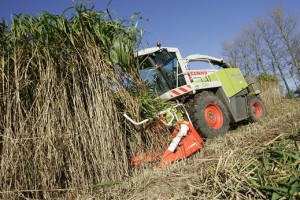
Replacing fossil fuels with biomass to produce energy is an effective way of reducing both CO2 emissions and a country’s energy dependency. At the same time, biomass energy can also be a powerful driver for rural development, the diversification of economy, value creation in rural areas, job creation and green growth in general. There is a general consensus in the bioenergy community on the potential socio-economic benefits of biomass value chains, however, estimating them in a quantifiable way is not an easy task, since a number of variables and local conditions that directly and indirectly affect value chains, must be factored in.
The European project LogistEC (Logistics for Energy Crops Biomass) has conducted a modeling analysis of the environmental, economic and social impacts of a biomass supply chain in France based on the cultivation of miscanthus, a perennial, rhizomatous grass with high rates of growth. The analysis provided evidence that growing biomass crops can bring significant socio-economic benefits in terms of economic activity and job creation at national and local level.
The analysis was focused on the region of Burgundy, in France, where 320 hectares of miscanthus and 60 hectares of switchgrass are currently cultivated by Bourgogne Pellets (BP), a farmer’s cooperative constituted by about 350 farmers and based in the municipality of Aiserey.
By performing an Input-Output Analysis, a tool that is often used to estimate the macro-economic impacts of industries on national and regional economies, LogistEC researchers were able to assess the interdependencies between activity sectors, the increase of production in goods and services, the value added and the creation of jobs. Considering an arable area of ~ 400 ha and the transport of biomass in form of chips and bales to the BP plant, the study resulted in a final aggregated production cost of 605 €/ha for miscanthus.
With these assumptions, a total production of goods and services of 6.91 M€ along the different sectors would be generated and 52 new jobs would be created, in order to fulfill the needs of a continuous production of miscanthus for 20 years. The multiplier effect would be 2.19, meaning that 1.00 euro of biomass available to the final user (BP) would generate 1.19 € in the global economy. The labor operations activities and the biomass transport activities would contribute the most to all socio-economic impacts.
These results will be further integrated in a Sustainability Multi-criteria Multi-scale Assessment (SUMMA) along with those obtained by a Life Cycle Analysis and an the Energy Analysis. This joint assessment will help in providing better insight into the biomass logistics system used in each case.
About
The LogistEC project, funded by the EU Seventh Framework Programme, aims at developing new and improved technologies for the biomass logistics chain by considering the environmental, economic and social aspects of sustainability.
This post is based on the paper “Socio-economic Effects of Biomass Supply Chain: Case Studies from LogistEC Project”, written by De la Rúa, C., Lechón, Y. et al. and presented at the 23rd European Biomass Conference Exhibition.


